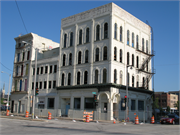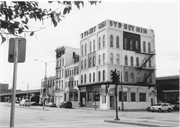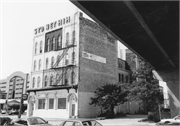Property Record
300 W JUNEAU AVE
Architecture and History Inventory
| Historic Name: | Nicholas Senn Building |
|---|---|
| Other Name: | Sidney HIH - Betty's Bead Bank |
| Contributing: | |
| Reference Number: | 16766 |
| Location (Address): | 300 W JUNEAU AVE |
|---|---|
| County: | Milwaukee |
| City: | Milwaukee |
| Township/Village: | |
| Unincorporated Community: | |
| Town: | |
| Range: | |
| Direction: | |
| Section: | |
| Quarter Section: | |
| Quarter/Quarter Section: |
| Year Built: | 1876 |
|---|---|
| Additions: | |
| Survey Date: | 2000 |
| Historic Use: | large retail building |
| Architectural Style: | Commercial Vernacular |
| Structural System: | |
| Wall Material: | Cream Brick |
| Architect: | |
| Other Buildings On Site: | |
| Demolished?: | Yes |
| Demolished Date: |
| National/State Register Listing Name: | Not listed |
|---|---|
| National Register Listing Date: | |
| State Register Listing Date: |
| Additional Information: | A 'site file' exists for this property. It contains additional information such as correspondence, newspaper clippings, or historical information. It is a public record and may be viewed in person at the State Historical Society, Division of Historic Preservation. Senn was a physician who had his office at this location. Damaged by fire 4/23/1980. This structure is the eastern anchor of the complex currently named "Sydney Hih." The brick building stands four stories high and features the ltalianate style of architecture most prominently through its fenestration. The storefront level was altered in 1910 for its new occupant, West Side Bank. Despite the first-floor alterations, the remaining three stories feature three bays of symmetrically arranged, round-arched windows which are set in paired or tripartite groupings that are separated by brick pilasters. Each corbeled hood mold features a keystone. An overhanging, copper cornice with bracket supports remains above the storefront level; however, the original pedimented and bracketed cornice of the overall structure has since been removed. The cornice now features large, block letters which spell out "SYDNEY HIH." In the late 1960s-early 1970s, the cream city brick structure was painted in its current, color-blocked scheme of pastel colors. This structure was erected by Dr. Nicholas Senn in 1876 at a cost of $8,000. Senn was born in Switzerland on 24 October 1844 and came to the United States with his parents in 1851 . He graduated from the Chicago Medical College in 1868 and, for the next six years, he practiced in Fond du Lac County. By 1874, Senn came to Milwaukee and shortly thereafter he was appointed as the Physician of the Milwaukee Hospital (what is now Sinai Samaritan). Senn erected this structure in 1876 to serve as his offices and laboratory, while the first floor was a pharmacy. Senn was a prolific surgeon who wrote no less than twenty-five books and over three hundred articles between circa 1874 and 1908. Senn gained national notoriety while practicing as a surgeon in Milwaukee between 1874 and 1893. Thereafter he removed to Chicago and passed away in 1908. Posthumous tributes to the doctor include the Chicagobased, Nicholas Senn Club (organized in 1908), the Senn Wing at the Milwaukee Hospital (now Sinai Samaritan Health Care Center-- dedicated in 1952) and the Senn Journal (a publication of the Milwaukee Hospital, from 1960-1976). A few of Dr. Senn's positions and titles include Vice President of the State Medical Society, delegate to the Medical Congress of the United States in 1876 and the 49th President of the American Medical Association. He is known in medical history as "the great master of abdominal surgery." Following Senn's occupation of the structure, the building was occupied by The West Side Bank. In 1910, alterations were made to the first floor by Leenhouts & Guthrie in order to accommodate the bank. In the late 1960s-early 1970s, this building and the three buildings adjacent to the west were purchased by Sydney Eisenberg and renamed Sydney Hih (Hih is Yiddish for In honor of). Eisenberg "envisioned the building as a haven for bohemians and referred to it as an arts and crafts center." Until recently, many of the upper floors were utilized as art and music studios as well as apartments. "Betty's Bead Bank" occupied the first floor of the block since 1976. The building's variegated paint scheme was added at this time. The four-building complex is for sale and only a few of the rooms/studios remain occupied. |
|---|---|
| Bibliographic References: | Tax program. Milwaukee Illustrated 1877, p. 85. Milwaukee Journal Sentinel 2/15/2000. Milwaukee Sentinel 3/3/1876. |
| Wisconsin Architecture and History Inventory, State Historic Preservation Office, Wisconsin Historical Society, Madison, Wisconsin |





